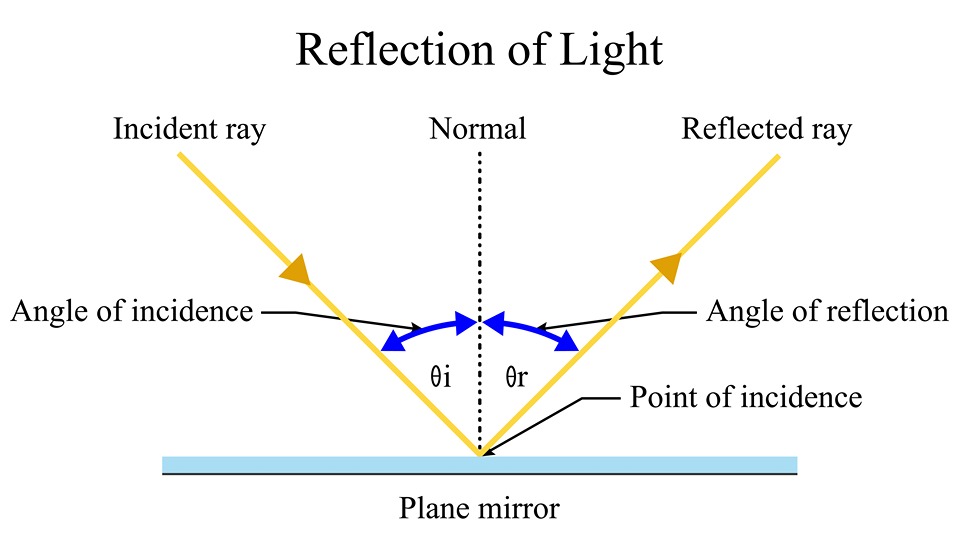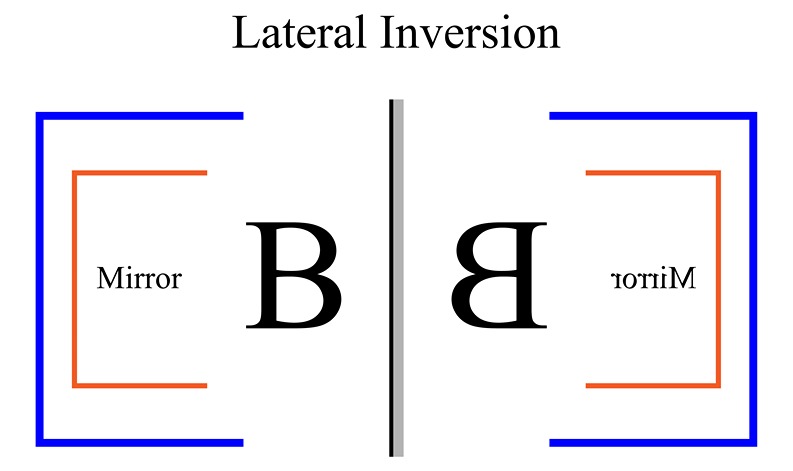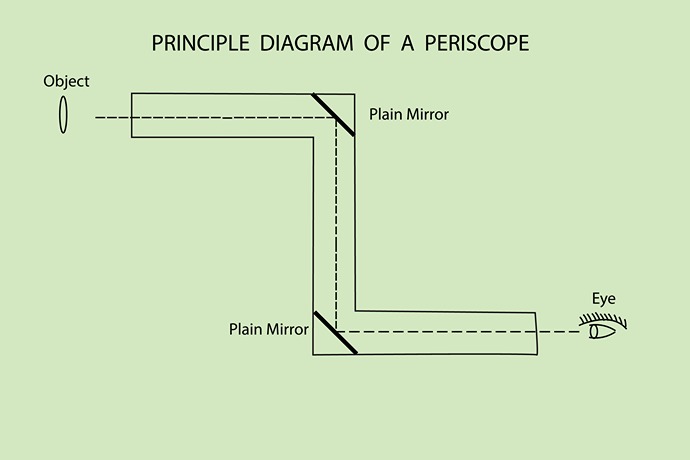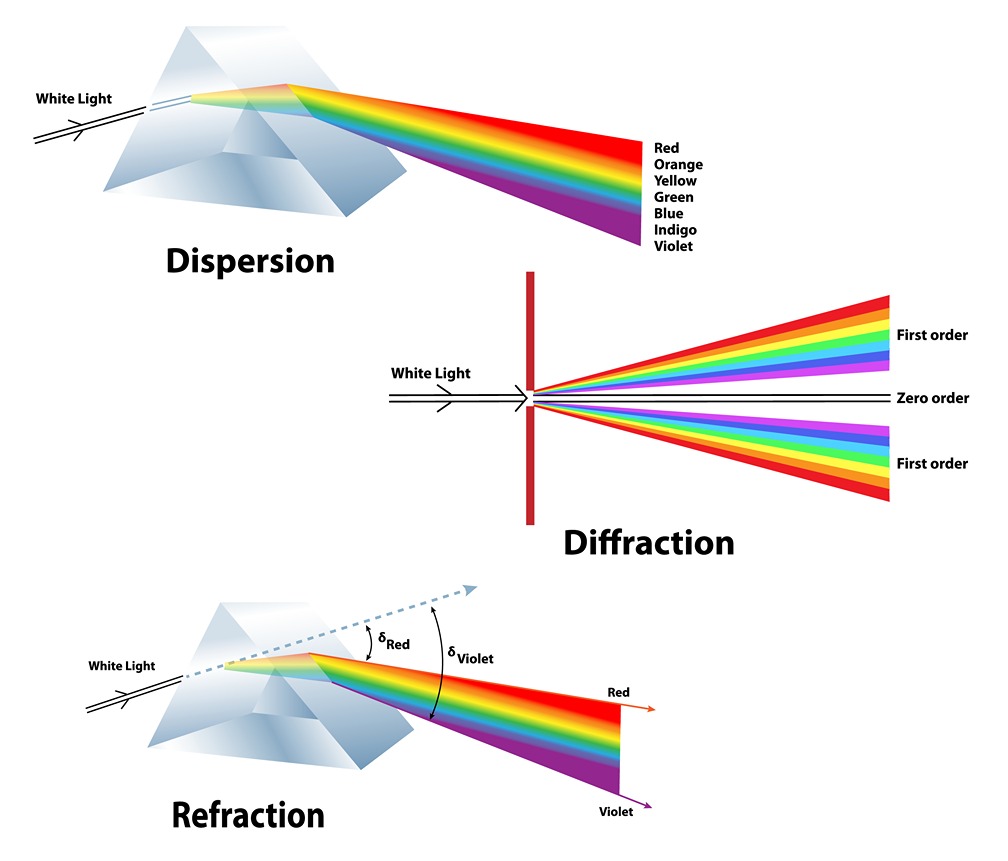Light Class 8 Notes NCERT and MCQs
 23-08-2023
23-08-2023
 17:14 PM IST
17:14 PM IST
 Yadvendra Singh
Yadvendra Singh
The chapter discusses laws of reflection, defines types of reflection and explains structure and working of eyes.
Light is reflected from all surfaces. It is the reflected or emitted light from an object that enters our eyes and we can see the object.
Types of Reflection
Diffused or irregular reflection: It takes place from rough surfaces. When all the parallel rays reflected from a rough or irregular surface are not parallel, the reflection is known as diffused or irregular reflection.
Regular reflection: Light is reflected from all surfaces. Regular reflection takes place when light is incident on smooth, polished and regular surfaces. Reflection from a smooth surface like that of a mirror is called regular reflection. Images are formed by regular reflection.

Fig.1: Types of reflection
Laws of reflection
Two laws of reflection are
(i) The angle of incidence is equal to the angle of reflection.
(ii) Incident ray, reflected ray and the normal drawn at the point of incidence to the reflecting surface, lie in the same plane.
Definitions of terms used above
- Normal: It is a line making an angle of 90º to the line representing the mirror at the point where the incident ray strikes the mirror.
- Incident ray: The light ray, which strikes any surface, is called the incident ray. The angle between the normal and incident ray is called the angle of incidence (i).
- Reflected ray: The ray that comes back from the surface after reflection is known as the reflected ray. The angle between the normal and the reflected ray is known as the angle of reflection (r).

Fig.2: Laws of Reflection
Lateral inversion
Image formed in a plane mirror undergoes lateral inversion. In an image formed by a mirror the left of the object appears on the right and the right appears on the left. This is known as lateral inversion.

Fig.3: Lateral Inversion
Periscope
- Reflected rays can be further reflected if incident on another mirror.
- The periscopes make use of two plane mirrors.
- They are used in submarines, tanks and also by soldiers in bunkers to see things outside.

Fig.4: Periscope
Kaleidoscope
- Two mirrors inclined to each other give multiple images.
- This idea of multiple mages formed by mirrors placed at an angle to one another is used in a kaleidoscope to make numerous beautiful patterns.
- Beautiful patterns are formed in a kaleidoscope because of multiple reflections. Same pattern can never be seen in a Kaleidoscope again.
Dispersion
Sunlight, called white light, consists of seven colours. Splitting of light into its constituent colours is known as dispersion. Rainbow is a natural phenomenon showing dispersion.

Fig.5: Dispersion of light
Structure and working of Human eye
The eye has a roughly spherical shape. Parts of the eye are cornea, iris, pupil, lens, retina and optic nerve.
- Outer coat: The outer coat of the eye is white. It is tough so that it can protect the interior of the eye from accidents.
- Cornea: Transparent front part of outer coat is called cornea.
- Iris: It is a dark muscular structure behind the cornea. Iris controls size of the pupil and amount of light entering into the eye. Iris gives eye its distinctive colour. When we say that a person has green eyes, we refer actually to the colour of the iris.
- Pupil: It is a small opening in the iris.
- Lens: It focuses light on the back of the eye, on a layer called retina.
- Retina: It contains two kinds of cells. They are cones and rods. While cones are sensitive to bright light, rods are sensitive to dim light. Cones sense colour.
- Blind spot: It is a spot at junction of the optic nerve and the retina, which do not have sensory cells. No vision is possible at blind spot.

Fig.6: Structure of Human eye
Some Important Facts related to Eye
- The impression of an image persists on retina for about 1/16th of a second.
- The movies that we see are a number of separate pictures moving across the eye usually at the rate of 24 pictures per second. So, separate pictures in a movie appear to us as moving.
- The most comfortable distance at which one can read with a normal eye is about 25 cm.
- Cataract: It is a situation in which eyesight becomes foggy in old age due to eye lens becoming cloudy. Cataract is treated by removing opaque lens and inserting new artificial lens.
- Eyes of a crab are small but crab can look all around and can sense even if the enemy approaches from behind.
- Butterflies have large eyes that seem to be made up of thousands of little eyes. They can see in front, sides and back.
- A night bird (owl) can see very well in the night but not during the day. It has a large cornea, a large pupil to allow more light in its eye and on its retina a large number of rods and only a few cones.
- The birds that see well during the day have more cones and fewer rods.
- Visually impaired persons can read and write using the Braille system. Braille system has 63 dot patterns or characters. Each character represents a letter, a combination of letters, a common word or a grammatical sign.
- Visually impaired persons develop their other senses more sharply to improve their interaction with their environment.
- Vitamin A deficiency causes night blindness. Raw carrots, broccoli and green vegetables (such as spinach) and cod liver oil are rich in vitamin A. Eggs, milk, curd, cheese, butter and fruits such as papaya and mango are also rich in vitamin A.
MCQs based on NCERT Class 8 Science Chapter 16: Light
1. As per the law of reflection, angle of incidence _____________angle of reflection.
a. is more than
b. is equal to
c. is less than
d. may be more or less than
Ans. b
Explanation:
Two laws of reflection are
(i) The angle of incidence is equal to the angle of reflection.
(ii) Incident ray, reflected ray and the normal drawn at the point of incidence to the reflecting surface, lie in the same plane.
2. In eye, dark muscular structure behind the cornea is known as
a. Iris
b. Pupil
c. Lens
d. Retina
Ans. a
Explanation:
In eye, dark muscular structure behind the cornea is known as Iris. It controls size of the pupil and amount of light entering into the eye. Iris gives eye its distinctive colour. When we say that a person has green eyes, we refer actually to the colour of the iris. Pupil is a small opening in the iris. Lens focuses light on the back of the eye, on a layer called retina. Retina contains two kinds of cells. They are cones and rods. While cones are sensitive to bright light, rods are sensitive to dim light. Cones sense colour.
3. The size of the pupil becomes ________ when you see in dim light.
a. Large
b. Small
c. Medium
d. Remains same
Ans. a
Explanation:
The size of pupil is controlled by the iris and the iris controls the light entering into the eye. The pupil becomes larger when one sees in dim light so that more light can go in.
4. Image formed by a plane mirror is
a. virtual, behind the mirror and enlarged.
b. virtual, behind the mirror and of the same size as the object.
c. real at the surface of the mirror and enlarged.
d. real, behind the mirror and of the same size as the object.
Ans. b
Explanation:
A plane mirror forms a virtual image behind the mirror. The size of the image is same as that of the object. The image formed is upright and is formed at the same distance from the plane mirror.
Frequently Asked Questions (FAQs) about Light
What are the laws of reflection?
What is dispersion?
What is the angle of incidence of a ray if the reflected ray is at an angle of 90° to the incident ray?
Share Blog
 Latest
Latest 
Comments